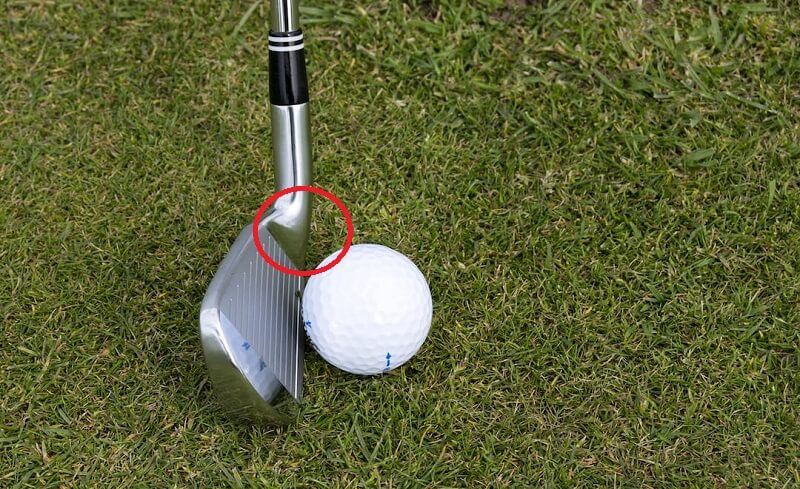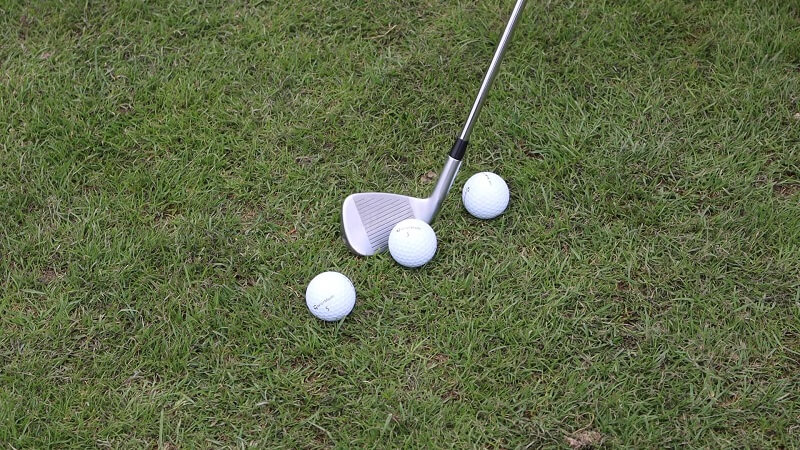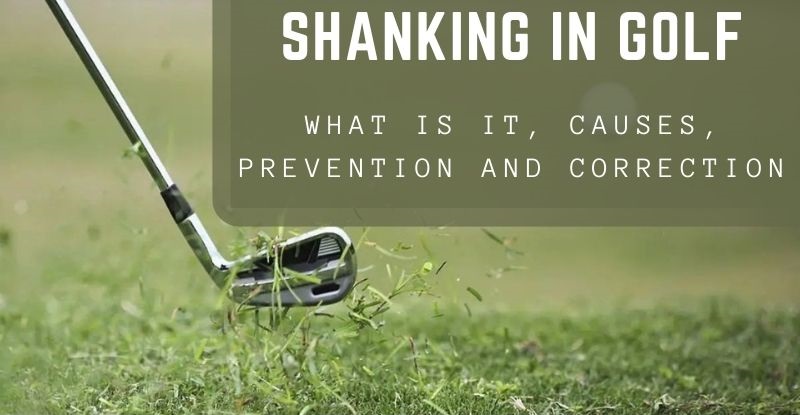Ah yes, the dreaded shank in golf. The term can strike fear into even the most seasoned golfer, as this type of shot is an all too common and often exceptionally embarrassing issue on the course. But what exactly is a “shank”? How does one prevent it from happening, and more importantly – how does one learn to fix it when it does occur?
We have answers to these queries and much more about this golfing phenomenon. Read on to discover why you should be concerned about shanking your shots, what causes them to happen, how you can adjust your approach or technique to reduce their occurrence and effective solutions that will help improve your game if they already are impacting your scorecard.
What Is A Golf Shank?

A golf shank is a shot in which the golf ball is struck on the hosel of the club instead of the clubface, causing the ball to shoot off sharply to the right (for a right-handed golfer) and often low and with little distance. It is considered one of the most frustrating shots in golf, as it can happen suddenly and seemingly without warning, even to skilled players.
The shank is also known as a “hosel rocket” or a “lateral.” It is a common problem among golfers of all levels but can be especially challenging to fix without proper instruction and practice.
The symptoms of a golf shank are pretty obvious. If you hit a shot that flies off to the right (for a right-handed golfer) and doesn’t go very far, you’ve likely hit a shank. The sound of the clubface hitting the hosel of the club is also a dead giveaway.
What Causes A Shank?
Shanking the ball is one of a golfer’s most frustrating experiences. It’s embarrassing, it kills your score, and you feel helpless to fix it. But don’t worry—it doesn’t have to be this way!
Understanding what causes shanks and how to fix them will help you take back your game and restore confidence in your swing. Below I will cover the common causes that cause a golf shank.
Poor Alignment
Poor alignment is one of the most common causes of shanking. When you’re not lined up properly, it’s easy to hit the ball off the hosel of the club, causing a shank.
When you’re not aligned correctly, your clubface will be pointed too far to the right (for a right-handed golfer) or too far to the left. This can cause the club to approach the ball from the wrong angle, leading to an impact with the hosel of the club.
Swing Path Issues
Swing path issues refer to the direction of the club head during the swing. If the clubhead approaches the ball from an outside-in path, it can lead to shanking. This happens because the clubhead strikes the ball on the hosel instead of the center of the clubface.
There are a few reasons why golfers might have an outside-in swing path. One common cause is an over-the-top move, where the upper body moves forward, and the club follows on an over-the-top path. Another cause is a too steep swing, where the clubhead approaches the ball on a steep angle.
Weight Distribution
Proper weight distribution is crucial for a good golf swing. If your weight is too far forward or back, it can lead to shanking the ball.
When your weight is too far forward, you’re likely to hit the ball with the hosel of the club, leading to a shank. This occurs because your body moves toward the ball as you swing, causing your arms to extend and the club head to move away from your body. If your weight is too far back, you may hit the ball with the toe of the club, which can also lead to shanking.
Grip Issues
Grip issues can also be a cause of shanking. A grip that is too tight or too loose can affect the swing and lead to a shank. When the grip is too tight, it can restrict the movement of the clubface and cause it to close during the swing, resulting in a shank. Conversely, a too-loose grip can cause the club to move around in hand, making it difficult to control the clubface and leading to a shank.
Club Selection
Using the wrong club can also contribute to shanking. For example, using a club with too much loft or too much bounce can cause the club to catch the ball too much on the hosel, resulting in a shank. Similarly, using a club that is too short or too long can cause you to stand too close or too far from the ball, leading to shaking.
How To Fix A Golf Shank?

Now that we’ve identified some of the causes of shanks, let’s explore some techniques and tips to help you fix them:
Improve Your Setup
The first step in fixing a golf shank is to check your setup. Many golfers make the mistake of standing too close to the ball, which can cause the clubface to hit the ball on the hosel. To avoid this, ensure your weight is evenly distributed and your feet are shoulder-width apart. Your hands should be slightly ahead of the ball, and your spine should be tilted slightly away from the target.
Check Your Grip
The next step is to check your grip. A too-weak or too-strong grip can cause the clubface to twist at impact, leading to a shank. Your hands should be placed on the club in a neutral position, and your thumbs should be pointing straight down the shaft. Ensure your grip is not too tight or loose, as this can also affect your swing.
Improve Your Swing Path
Another common cause of shanks is an over-the-top swing. This occurs when the club comes down from outside the target line, causing the clubface to hit the ball on the hosel. To fix this problem, try to make a shallower swing by focusing on turning your hips and shoulders. Keep your arms and hands relaxed, and let the club do the work.
Practice with a Tee
If you struggle to fix your shank, place a tee about an inch outside the ball and a few inches in front of it. This will help you focus on hitting the ball in the center of the clubface. You can also try hitting balls off a mat or tee outside your front foot to encourage a more inside-out swing path.
See a Professional
If you’re still struggling to fix your shank, it may be time to seek professional help. A golf professional can analyze your swing and help you make the necessary adjustments. They can also recommend drills and exercises that will help you improve your game.
How To Recover From Shanks On The Course?
The first thing you should do is take a deep breath and try to relax. Panicking and getting frustrated will only make things worse. Once you’ve calmed down, take a moment to analyze what went wrong. Did you take your eye off the ball? Did you swing too hard? Did you lose your balance? Understanding what caused the shank can help you prevent it from happening again.
If you’re on the course and you’ve shanked your shot, the best thing you can do is to take your medicine and try to salvage the hole. Take a deep breath, regroup, and focus on hitting a solid shot that will get you back on track. If you’re still struggling with shanking, you can try switching to a different club or taking a break to practice your swing on the driving range. Remember, golf is a mental game as much as it is a physical one. Stay positive and keep your confidence up, even if you’re not hitting your best shots.
Another tip for recovering from shanks on the course is to play with a good attitude. Don’t let one bad shot ruin your entire round. Golf is a challenging game, and everyone has bad days on the course. Keep a positive attitude, have fun, and enjoy the beautiful surroundings.
Practicing Drills To Help Reduce Shanking Tendencies

Shanking can be a frustrating experience, but practicing drills can help you overcome it. Here are some effective drills to help reduce your shanking tendencies:
Headcover or Towel Drill
One effective drill to help reduce shanking tendencies is the headcover or towel drill. To perform this drill, place a headcover or towel just outside the ball and focus on hitting the ball without touching the headcover or towel. This drill helps you focus on hitting the ball in the center of the clubface, which is where you want to make contact with the ball. By consistently hitting the ball in the center of the clubface, you can develop a more consistent swing and reduce your shanking tendencies.
Alignment Stick Drill
Another great drill to reduce shanking tendencies is the alignment stick drill. To perform this drill, place an alignment stick or club on the ground just outside your ball and focus on swinging the club over the stick. This helps you swing on the correct plane and avoid swinging too far inside or outside, which can cause shanking. The alignment stick also helps you keep your swing on a straight path, reducing the chances of hitting the ball off the hosel.
One-Legged Drill
If you tend to lose your balance during your swing, you can practice the one-legged drill. To perform this drill, stand on one leg and practice your swing, focusing on maintaining your balance throughout the swing. This drill helps you develop stability and prevent shanking due to losing balance. Practicing this drill regularly can improve your balance and reduce your shanking tendencies.
Slow Motion Swing
Practice a slow-motion swing to help you feel the correct swing path and release. This drill helps you avoid rushing your swing and can help you eliminate shanking tendencies.
Conclusion
Shanking in golf can be a major obstacle for any golfer looking to improve their game. By understanding the causes of shanking and taking proactive steps to combat it, golfers can reduce shanking tendencies and get back to playing their best. Practicing drills, visualizing success, and staying positive are all important aspects of avoiding shanks when under pressure. With the right strategy and dedication, golfers can reduce shanking and achieve great success on the course.
Following these tips and techniques allows any golfer to become more confident and play better than ever before. So don’t be discouraged by golf shank; any golfer can reach their full potential with practice.
Hope this helps!
FAQs
Why Am I Shanking The Golf Ball?
A shank is a common golfing mistake experienced by many players. Causes of shanking can include an overly-narrow stance, gripping the club too tightly, and making contact with the ball off the heel of the clubface instead of its sweet spot.
Can Shanking In Golf Be Fixed Quickly?
Unfortunately, shanking is not something that can be fixed overnight. It takes time, patience, and practice to overcome this issue. But with dedication and persistence, you can improve your game and fix your shanks.
Should I Seek Professional Help To Fix My Shanks?
If you’re struggling with shanks and can’t seem to fix the problem on your own, it may be worth seeking professional help. A golf instructor can provide personalized feedback and guidance to help you overcome this issue.
How Often Should I Practice Fixing My Shanks?
There’s no set answer to this question, as it varies from person to person.
What Different Types Of The Shank In Golf?
There are two main types of golf shank: a heel shank and a toe shank. A heel shank occurs when a golfer strikes the ball with a downward swing, resulting in a shot that curves to the right of the target. A toe shank occurs when a golfer strikes the ball with an upward swing, resulting in a shot that curves to the left of the target.
What Are The Differences Between A Slice And A Shank?
The main difference between a slice and a shank in golf is the path of the ball. A slice occurs when a player’s clubface strikes the ball at an angle, causing it to spin off in a curved trajectory that goes right-to-left (for right-handed players). A shank occurs when the ball is struck close to the hosel of the club, resulting in a trajectory that curves sharply left-to-right (for right-handed players). In both cases, improper technique and positioning can lead to mis-hits.


